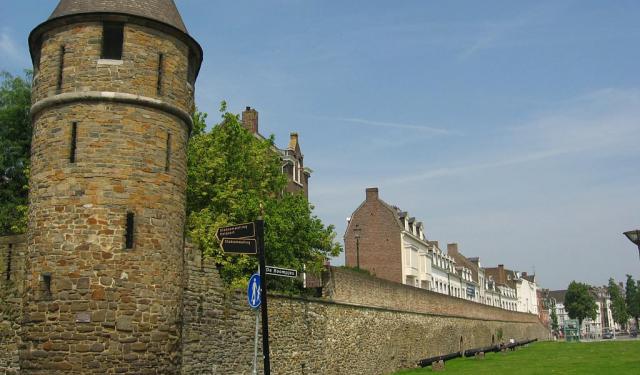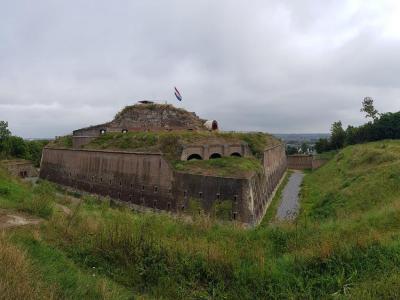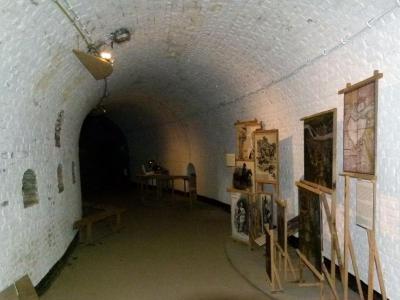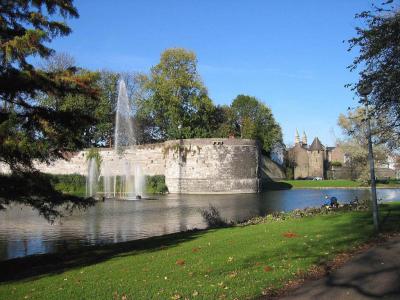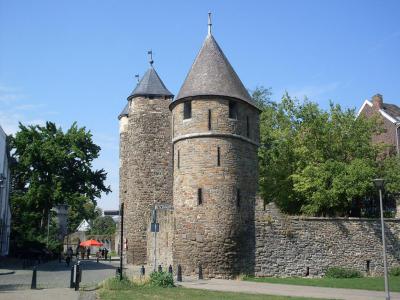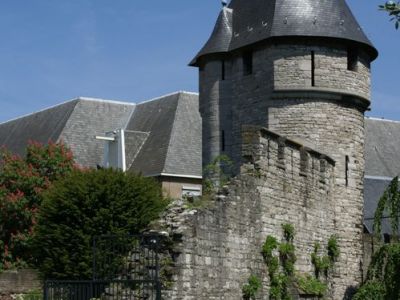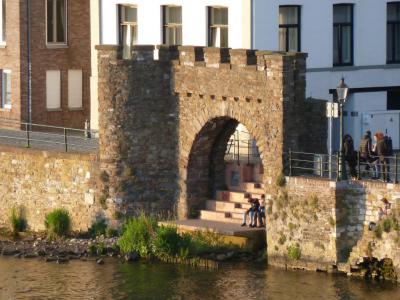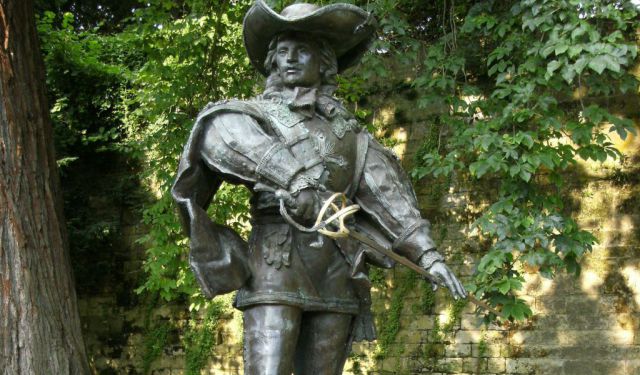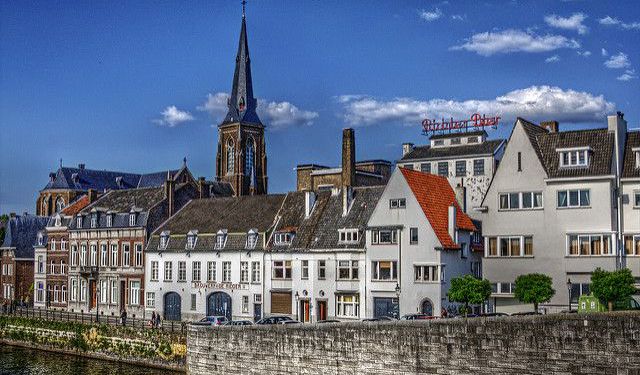Maastricht Ancient Fortification Sites (Self Guided), Maastricht
As a key meeting point for European cultures and trading routes, Maastricht for millennia had been the site of many battles. Once known as the "Bulwark of the Netherlands", the city earned its reputation thanks to the impenetrable defenses that lasted through multiple attacks on its strategic position.
The very first fortifications in Maastricht appeared around the 1200s. Some of them are still in place today, wholly or partially, seamlessly merged with the structures of later ages, and making pleasant places to walk around. Among them are such prominent sites as:
Fort St. Pieter (Saint Peter's Fortress) – a fantastic looking hexagonal construction, part of the defense works that protected the city during the 18th-19th centuries; full of tunnels and caves, while imposing, it only ever saw a single battle; a visit here brings you back to older times, where soldiers and musketeers roamed the hallways;
Waldeck Park Casemates – these ancient marlstone mines have more than 20,000 passages decorated with generations of graffiti. During WWII these quarry tunnels were converted into an air raid shelter, but were never used;
Helpoort (Hell's Gate) – one of the iconic monuments that give Maastricht its special atmosphere; forms part of the Old Town wall built in the 13th century. This was one of the main entrances to Maastricht and today is the oldest Dutch city gate still standing.
There are many secrets, legends and myths associated with Maastricht's splendid defensive structures. If you're keen to reveal some of them and explore the city's ancient gates, forts, bastions and ramparts in more detail, take this self-guided walking tour.
The very first fortifications in Maastricht appeared around the 1200s. Some of them are still in place today, wholly or partially, seamlessly merged with the structures of later ages, and making pleasant places to walk around. Among them are such prominent sites as:
Fort St. Pieter (Saint Peter's Fortress) – a fantastic looking hexagonal construction, part of the defense works that protected the city during the 18th-19th centuries; full of tunnels and caves, while imposing, it only ever saw a single battle; a visit here brings you back to older times, where soldiers and musketeers roamed the hallways;
Waldeck Park Casemates – these ancient marlstone mines have more than 20,000 passages decorated with generations of graffiti. During WWII these quarry tunnels were converted into an air raid shelter, but were never used;
Helpoort (Hell's Gate) – one of the iconic monuments that give Maastricht its special atmosphere; forms part of the Old Town wall built in the 13th century. This was one of the main entrances to Maastricht and today is the oldest Dutch city gate still standing.
There are many secrets, legends and myths associated with Maastricht's splendid defensive structures. If you're keen to reveal some of them and explore the city's ancient gates, forts, bastions and ramparts in more detail, take this self-guided walking tour.
How it works: Download the app "GPSmyCity: Walks in 1K+ Cities" from Apple App Store or Google Play Store to your mobile phone or tablet. The app turns your mobile device into a personal tour guide and its built-in GPS navigation functions guide you from one tour stop to next. The app works offline, so no data plan is needed when traveling abroad.
Maastricht Ancient Fortification Sites Map
Guide Name: Maastricht Ancient Fortification Sites
Guide Location: Netherlands » Maastricht (See other walking tours in Maastricht)
Guide Type: Self-guided Walking Tour (Sightseeing)
# of Attractions: 7
Tour Duration: 2 Hour(s)
Travel Distance: 3.3 Km or 2.1 Miles
Author: ellen
Sight(s) Featured in This Guide:
Guide Location: Netherlands » Maastricht (See other walking tours in Maastricht)
Guide Type: Self-guided Walking Tour (Sightseeing)
# of Attractions: 7
Tour Duration: 2 Hour(s)
Travel Distance: 3.3 Km or 2.1 Miles
Author: ellen
Sight(s) Featured in This Guide:
- Fort St. Pieter (Saint Peter's Fortress)
- Maastricht Underground
- Waldeck Park Casemates
- De Vijf Koppen (The Five Heads) Bastion
- Helpoort (Hell's Gate)
- Pater Vinktoren (Father Vinck Tower)
- Wycker Waterpoort (Wycker Watergate)
1) Fort St. Pieter (Saint Peter's Fortress) (must see)
Perched atop Saint Peter’s Mount, Saint Peter’s Fortress (Fort Sint Pieter) is a historic military structure in Maastricht. Constructed in the 18th century, the fortress was designed to strengthen the city’s defenses following the devastating French invasion and sack of Maastricht in 1673. Its imposing hexagonal shape, thick walls, and extensive underground tunnels made it a formidable stronghold.
The fortress was put to the test in 1793 when a Dutch garrison of 4,500 men, under the command of Prince Frederick of Hesse-Kassel, successfully defended Maastricht against a 15,000-strong French army. The defensive design, featuring gunnery windows and strategic fortifications, proved nearly impenetrable. However, in 1794, during another French siege led by General Kléber, the fortress was attacked from the rear. Though it withstood significant force, the fort was ultimately decommissioned in the 19th century and underwent modernization.
Today, Saint Peter’s Fortress is a well-preserved historical site offering guided tours that take visitors through its intricate network of tunnels, cannon galleries, and a hidden water well. From its elevated position, the fortress provides stunning panoramic views of Maastricht and the surrounding Limburg countryside. Visitors can also explore the nearby marl caves, which are closely linked to the fortress, and enjoy the charming eateries and walking trails around the site.
Restored in 2011, the fortress remains an enduring symbol of Maastricht’s resilience. It serves as both a reminder of the city’s turbulent past and a popular attraction for those interested in military history, architecture, and scenic landscapes. Tickets for tours can be purchased at the adjacent Maastricht Underground shop, where visitors can also book combination tours that include cave explorations or cycling excursions.
The fortress was put to the test in 1793 when a Dutch garrison of 4,500 men, under the command of Prince Frederick of Hesse-Kassel, successfully defended Maastricht against a 15,000-strong French army. The defensive design, featuring gunnery windows and strategic fortifications, proved nearly impenetrable. However, in 1794, during another French siege led by General Kléber, the fortress was attacked from the rear. Though it withstood significant force, the fort was ultimately decommissioned in the 19th century and underwent modernization.
Today, Saint Peter’s Fortress is a well-preserved historical site offering guided tours that take visitors through its intricate network of tunnels, cannon galleries, and a hidden water well. From its elevated position, the fortress provides stunning panoramic views of Maastricht and the surrounding Limburg countryside. Visitors can also explore the nearby marl caves, which are closely linked to the fortress, and enjoy the charming eateries and walking trails around the site.
Restored in 2011, the fortress remains an enduring symbol of Maastricht’s resilience. It serves as both a reminder of the city’s turbulent past and a popular attraction for those interested in military history, architecture, and scenic landscapes. Tickets for tours can be purchased at the adjacent Maastricht Underground shop, where visitors can also book combination tours that include cave explorations or cycling excursions.
2) Maastricht Underground (must see)
Maastricht Underground is a collection of caves. The caves are also called the Caves of Maastricht or the caves of Mount Saint Peter.
The caves were originally dug in the 13th century to mine chalk. A total of 20,000 tunnels were cut. When lime's value dropped, locals stopped mining. Instead, they started drawing art on the cave's walls. Today, 8,000 tunnels remain spread over 80 kilometers.
During World War II, the caves were used to store paintings. The Night Watch by Rembrandt was one of the paintings hidden in the caves. Rembrandt's famous painting was removed from its frame and rolled into a cylinder for safe-keeping. Locals also stored armaments such as tanks in the cave system.
In addition, over 6,000 locals sheltered in the caves during World War II. The evacuation area features electric lights, a small hospital, a public address system, chapels, a bakery, toilets, and water pumps.
Visitors can explore the caves on a guided walking or scooter tour. It is recommended that visitors bring a coat as the underground caves are quite cold.
Visitors can arrange different tour packages and visit different areas of the caves. The Zonneberg Cave system includes the World War II air-raid shelter. Guests can also see a full-size charcoal version of The Night Watch.
In the North Caves, visitors will descend 30 meters (98 feet) below the surface. This tour features an area where families hid in the caves with their cattle. Visitors can see the oven where the families baked bread.
Visitors can also take private tours or tours catering to kids.
The caves were originally dug in the 13th century to mine chalk. A total of 20,000 tunnels were cut. When lime's value dropped, locals stopped mining. Instead, they started drawing art on the cave's walls. Today, 8,000 tunnels remain spread over 80 kilometers.
During World War II, the caves were used to store paintings. The Night Watch by Rembrandt was one of the paintings hidden in the caves. Rembrandt's famous painting was removed from its frame and rolled into a cylinder for safe-keeping. Locals also stored armaments such as tanks in the cave system.
In addition, over 6,000 locals sheltered in the caves during World War II. The evacuation area features electric lights, a small hospital, a public address system, chapels, a bakery, toilets, and water pumps.
Visitors can explore the caves on a guided walking or scooter tour. It is recommended that visitors bring a coat as the underground caves are quite cold.
Visitors can arrange different tour packages and visit different areas of the caves. The Zonneberg Cave system includes the World War II air-raid shelter. Guests can also see a full-size charcoal version of The Night Watch.
In the North Caves, visitors will descend 30 meters (98 feet) below the surface. This tour features an area where families hid in the caves with their cattle. Visitors can see the oven where the families baked bread.
Visitors can also take private tours or tours catering to kids.
3) Waldeck Park Casemates
The Casemates (Kazematten) is a network of underground tunnels and former chalk mine galleries located in Waldeck Park – the scene of many violent battles, back in the past. As a defense system, the casemates were created over the period from 1575 to 1825, totaling 14 km in length.
The Waldeck bastion was constructed following the siege of the city in 1688-90 for the purpose of strengthening the outworks on the south-west side. Commissioned by the fortress engineer Daniël Wolff baron van Dopff, it is named after George Frederik van Waldeck-Eisenberg, the military governor of Maastricht (1679-92), and was a seconded fortification – not attached to the main wall. During the dismantling of the Maastricht fortress, in 1867, it was partially destroyed.
From 1770 to 1780, the outer wall of the dry moat was reinforced with a counter scarp of masonry bricks with marl blocks in chains at regular intervals. Behind this wall is a caponier, an elongated, curved casemate with embrasures from which an enemy, ventured into the dry moat, could be fired at from behind. The caponier is linked via corridors to the underground mine system of Maastricht.
Also there are listening and communication corridors used for eavesdropping on enemies.
The history of the casemates is remarkably associated with the legendary French musketeer d'Artagnan who was killed during the siege of Maastricht in 1673. There is a lot of information about him inside the casemates, plus an impressive statue outside, in Waldeck park.
At the time of WWII, locals also put the underground tunnels – capable of holding up to 30,000 people – to a good use, hiding from the Germans. The newest part of the network was built in the 20th century, during the Cold War, to serve as a shelter in case of a nuclear attack on Maastricht.
The Waldeck bastion was constructed following the siege of the city in 1688-90 for the purpose of strengthening the outworks on the south-west side. Commissioned by the fortress engineer Daniël Wolff baron van Dopff, it is named after George Frederik van Waldeck-Eisenberg, the military governor of Maastricht (1679-92), and was a seconded fortification – not attached to the main wall. During the dismantling of the Maastricht fortress, in 1867, it was partially destroyed.
From 1770 to 1780, the outer wall of the dry moat was reinforced with a counter scarp of masonry bricks with marl blocks in chains at regular intervals. Behind this wall is a caponier, an elongated, curved casemate with embrasures from which an enemy, ventured into the dry moat, could be fired at from behind. The caponier is linked via corridors to the underground mine system of Maastricht.
Also there are listening and communication corridors used for eavesdropping on enemies.
The history of the casemates is remarkably associated with the legendary French musketeer d'Artagnan who was killed during the siege of Maastricht in 1673. There is a lot of information about him inside the casemates, plus an impressive statue outside, in Waldeck park.
At the time of WWII, locals also put the underground tunnels – capable of holding up to 30,000 people – to a good use, hiding from the Germans. The newest part of the network was built in the 20th century, during the Cold War, to serve as a shelter in case of a nuclear attack on Maastricht.
4) De Vijf Koppen (The Five Heads) Bastion
The Five Heads (De Vief Kop) is a late 15th-century to early 16th-century roundel located in the Nieuwstad area of Maastricht. Alongside the nearby Haet ende Nijt roundel, it formed an extension of Maastricht's second city wall, originally built in the late 13th century. Today, both structures are designated national monuments and are prominent features of the Maastricht City Park.
Like many historical fortifications, the Five Heads was initially unnamed. Early references from 1528 describe it as ''the new tower in the Nieuwstad near the Maas''. The infamous name "The Five Heads" originates from a gruesome event in 1638, when, after the failed Betrayal of Maastricht, the severed heads of five conspirators were displayed here on a stake. The term "De Vijf Koppen" likely came into common use by the late 19th century, spurred by a Catholic movement seeking the rehabilitation of the so-called traitors.
The Five Heads saw restoration efforts in 2018, including work on the courtine wall, a replica of the 1638 wooden stake, and a gun carriage with a cast iron cannon. On March 24, 2019, part of the city wall collapsed due to moisture and erosion. Temporary supports were added, with restoration planned for mid-2023.
Architecturally, the Five Heads is slightly more than semi-circular, with a diameter of approximately eighteen meters. The structure is faced with Namur stone, beneath which lies a core of marlstone, with the majority of the roundel filled with rubble and earth. Unlike Haet ende Nijt, which features a sculpted frieze along its outer edge, the Five Heads does not possess such ornamentation. The eastern wall was repaired with bricks, and a Namur stone engraved with crossed cannon barrels and two bullets was embedded nearby. Additionally, three corbels can be seen on the southeast-facing side, which once supported a cage.
The Five Heads remains an integral part of Maastricht’s historical landscape, standing as both a reminder of its turbulent past and a key feature of its scenic city park.
Like many historical fortifications, the Five Heads was initially unnamed. Early references from 1528 describe it as ''the new tower in the Nieuwstad near the Maas''. The infamous name "The Five Heads" originates from a gruesome event in 1638, when, after the failed Betrayal of Maastricht, the severed heads of five conspirators were displayed here on a stake. The term "De Vijf Koppen" likely came into common use by the late 19th century, spurred by a Catholic movement seeking the rehabilitation of the so-called traitors.
The Five Heads saw restoration efforts in 2018, including work on the courtine wall, a replica of the 1638 wooden stake, and a gun carriage with a cast iron cannon. On March 24, 2019, part of the city wall collapsed due to moisture and erosion. Temporary supports were added, with restoration planned for mid-2023.
Architecturally, the Five Heads is slightly more than semi-circular, with a diameter of approximately eighteen meters. The structure is faced with Namur stone, beneath which lies a core of marlstone, with the majority of the roundel filled with rubble and earth. Unlike Haet ende Nijt, which features a sculpted frieze along its outer edge, the Five Heads does not possess such ornamentation. The eastern wall was repaired with bricks, and a Namur stone engraved with crossed cannon barrels and two bullets was embedded nearby. Additionally, three corbels can be seen on the southeast-facing side, which once supported a cage.
The Five Heads remains an integral part of Maastricht’s historical landscape, standing as both a reminder of its turbulent past and a key feature of its scenic city park.
5) Helpoort (Hell's Gate)
Hell’s Gate (Dutch: Helpoort) is a striking medieval landmark located in the Jekerkwartier district of Maastricht. Built shortly after 1229, when Henry I, Duke of Brabant, authorized the construction of stone fortifications, the gate is part of the city's first city wall and stands as the oldest surviving city gate in the Netherlands.
Originally called Hoogbruggepoort (“gate of the high bridge”), the structure was likely completed around 1230 and served as a defensive stronghold for nearly two centuries. Positioned near the Jeker River, the gate once connected to a bridge and was one of thirteen city gates in the original wall system-walls made of coal sandstone that stretched about 2.4 kilometers and were dotted with towers and water gates.
Hell’s Gate stands 14 meters (46 feet) tall and played a key role in protecting the city until the 15th century when Maastricht expanded and new fortifications (the Second City Walls) made the gate obsolete as a main entry point. After losing its military function, the gate had a second life in various roles: armory, powder magazine, a meeting place for cloth makers, and even a private residence.
Today, the Helpoort is home to a small but engaging museum focused on Maastricht’s fortification history. Tucked away on a quiet square, the museum is staffed by volunteers who share historical insights with visitors. Guests can also climb the gate’s tower for panoramic views of the old town.
Hell’s Gate is more than just a medieval relic-it’s a symbol of Maastricht’s layered past and a unique piece of Dutch heritage still standing proud in the heart of the city.
Originally called Hoogbruggepoort (“gate of the high bridge”), the structure was likely completed around 1230 and served as a defensive stronghold for nearly two centuries. Positioned near the Jeker River, the gate once connected to a bridge and was one of thirteen city gates in the original wall system-walls made of coal sandstone that stretched about 2.4 kilometers and were dotted with towers and water gates.
Hell’s Gate stands 14 meters (46 feet) tall and played a key role in protecting the city until the 15th century when Maastricht expanded and new fortifications (the Second City Walls) made the gate obsolete as a main entry point. After losing its military function, the gate had a second life in various roles: armory, powder magazine, a meeting place for cloth makers, and even a private residence.
Today, the Helpoort is home to a small but engaging museum focused on Maastricht’s fortification history. Tucked away on a quiet square, the museum is staffed by volunteers who share historical insights with visitors. Guests can also climb the gate’s tower for panoramic views of the old town.
Hell’s Gate is more than just a medieval relic-it’s a symbol of Maastricht’s layered past and a unique piece of Dutch heritage still standing proud in the heart of the city.
6) Pater Vinktoren (Father Vinck Tower)
The Father Vinck Tower (Pater Vincktoren) is a 14th-century rampart in Maastricht, forming part of the city's Second City Walls. Originally known as the tower behind the Feilzusters or the tower at the Swesteren, it was strategically designed to defend the swampy area near the Jeker gateway. Construction of the tower was completed between 1370 and 1380, serving as a crucial connection point between the First and Second City Walls.
In 1867, when King Willem III ordered the dismantling of Maastricht’s fortress status, the tower, located behind the Faliezusters Convent (Faliezustersklooster), faced near-total destruction. Fortunately, it was restored in 1906 by architect W. Sprenger, preserving its medieval defensive structure. Despite the lack of any direct historical connection, the tower was subsequently named after Father Servatius Vinck, a Franciscan priest executed in 1638 for allegedly betraying Maastricht. His head, along with those of four other accused traitors, was displayed on a neighboring bastion, later known as The Five Heads. The naming of the tower can be seen as an early 20th-century effort to rehabilitate these Catholic figures in the context of rising Catholic identity and resistance to Dutch rule.
The Father Vinck Tower is a two-story structure, with the first level leading to the parapet and the second accessible via a staircase from the city side. A notable architectural detail is a cat-shaped gargoyle positioned between the first and second floors. Today, the tower stands as a well-preserved historical landmark, forming a picturesque scene in Maastricht City Park alongside a section of the city wall and a nearby water gate. Its striking appearance makes it one of the most photographed sites in the city, blending medieval heritage with the scenic beauty of the park.
In 1867, when King Willem III ordered the dismantling of Maastricht’s fortress status, the tower, located behind the Faliezusters Convent (Faliezustersklooster), faced near-total destruction. Fortunately, it was restored in 1906 by architect W. Sprenger, preserving its medieval defensive structure. Despite the lack of any direct historical connection, the tower was subsequently named after Father Servatius Vinck, a Franciscan priest executed in 1638 for allegedly betraying Maastricht. His head, along with those of four other accused traitors, was displayed on a neighboring bastion, later known as The Five Heads. The naming of the tower can be seen as an early 20th-century effort to rehabilitate these Catholic figures in the context of rising Catholic identity and resistance to Dutch rule.
The Father Vinck Tower is a two-story structure, with the first level leading to the parapet and the second accessible via a staircase from the city side. A notable architectural detail is a cat-shaped gargoyle positioned between the first and second floors. Today, the tower stands as a well-preserved historical landmark, forming a picturesque scene in Maastricht City Park alongside a section of the city wall and a nearby water gate. Its striking appearance makes it one of the most photographed sites in the city, blending medieval heritage with the scenic beauty of the park.
7) Wycker Waterpoort (Wycker Watergate)
The Wycker Watergate, also known as Waterpoortje, is a medieval water gate located in the Wyck district of Maastricht. Positioned on the Maaskade (Stenenwal) at the junction of Waterpoort Street and the River Maas, this historical structure has been a national monument since 1966.
Built as part of the Wycker city wall in 1318, the water gate likely dates to the 14th century, providing access to an unloading quay. First mentioned in a 1377 tax book as "magnam portam que ducit ad Mosam" (the large gate to the Meuse), it was renamed Symon Mertynsport by 1399-1400 after timber merchant Simon Mertens. Later, it was known as Wycker Kolenpoort in the 16th century and Batpoort in the 17th, though the latter name applied to multiple gates.
The structure consists of a thick wall made of coal sandstone, featuring a round-arched gate opening approximately 3.5 meters wide. In 1897, the gate was slightly set back relative to the quay wall, possibly restoring its original positioning. The connection to the quay was reinforced by two tower-like extensions designed by architect Pierre Cuypers. However, these extensions, which feature battlements, are largely decorative and not historically referenced. A wall walk is present above the gate on the city side, though it remains inaccessible.
Since 2007, a red stone staircase in the gate opening leads to a viewing platform near the water, surrounded by Maas boulders for protection. South of the gate, a bluestone staircase is embedded in the quay wall, its origin unknown. Further south, near the Maaspunt Tower, a now-bricked-up water gate may have served the Clermont & Chinay pottery factory (1851) for river transport.
Today, the Wycker Watergate stands as a testament to Maastricht’s medieval fortifications, preserving its historical significance while offering modern visitors a glimpse into the city’s past.
Built as part of the Wycker city wall in 1318, the water gate likely dates to the 14th century, providing access to an unloading quay. First mentioned in a 1377 tax book as "magnam portam que ducit ad Mosam" (the large gate to the Meuse), it was renamed Symon Mertynsport by 1399-1400 after timber merchant Simon Mertens. Later, it was known as Wycker Kolenpoort in the 16th century and Batpoort in the 17th, though the latter name applied to multiple gates.
The structure consists of a thick wall made of coal sandstone, featuring a round-arched gate opening approximately 3.5 meters wide. In 1897, the gate was slightly set back relative to the quay wall, possibly restoring its original positioning. The connection to the quay was reinforced by two tower-like extensions designed by architect Pierre Cuypers. However, these extensions, which feature battlements, are largely decorative and not historically referenced. A wall walk is present above the gate on the city side, though it remains inaccessible.
Since 2007, a red stone staircase in the gate opening leads to a viewing platform near the water, surrounded by Maas boulders for protection. South of the gate, a bluestone staircase is embedded in the quay wall, its origin unknown. Further south, near the Maaspunt Tower, a now-bricked-up water gate may have served the Clermont & Chinay pottery factory (1851) for river transport.
Today, the Wycker Watergate stands as a testament to Maastricht’s medieval fortifications, preserving its historical significance while offering modern visitors a glimpse into the city’s past.
Walking Tours in Maastricht, Netherlands
Create Your Own Walk in Maastricht
Creating your own self-guided walk in Maastricht is easy and fun. Choose the city attractions that you want to see and a walk route map will be created just for you. You can even set your hotel as the start point of the walk.
Maastricht's Historical Buildings Walking Tour
Founded by the Romans some 2,000 years ago, the charming city of Maastricht is one of the oldest in the Netherlands. Its long history is manifested in numerous remnants, including religious and secular buildings of any form. Over the course of the centuries, Maastricht has garnered a wealth of architecture, featuring a variety of styles: Gothic, Baroque, Romanesque and Renaissance.
Cultural... view more
Tour Duration: 2 Hour(s)
Travel Distance: 3.1 Km or 1.9 Miles
Cultural... view more
Tour Duration: 2 Hour(s)
Travel Distance: 3.1 Km or 1.9 Miles
Statues and Monuments Tour
The citizens of Maastricht are reputed to be spiritual and have a good sense of humor. Their attitude towards life, as well as their customs and traditions, are vividly reflected in the numerous statues and monuments scattered throughout the city.
Among these is the Statue of Jan Pieter Minckeleers, commemorating the local inventor of gas lighting. Another notable figure is the Mooswief, also... view more
Tour Duration: 1 Hour(s)
Travel Distance: 2.1 Km or 1.3 Miles
Among these is the Statue of Jan Pieter Minckeleers, commemorating the local inventor of gas lighting. Another notable figure is the Mooswief, also... view more
Tour Duration: 1 Hour(s)
Travel Distance: 2.1 Km or 1.3 Miles
Maastricht Introduction Walking Tour
Maastricht is an ancient city known for its rich history, medieval architecture, and vibrant cultural scene.
In the first century AD, the Romans built a bridge across the Meuse river. A settlement grew near the bridge. Maastricht's name means "a place to cross the Meuse river". Today, a pillar marks this location of the original Roman bridge.
The Roman settlement was small,... view more
Tour Duration: 2 Hour(s)
Travel Distance: 2.2 Km or 1.4 Miles
In the first century AD, the Romans built a bridge across the Meuse river. A settlement grew near the bridge. Maastricht's name means "a place to cross the Meuse river". Today, a pillar marks this location of the original Roman bridge.
The Roman settlement was small,... view more
Tour Duration: 2 Hour(s)
Travel Distance: 2.2 Km or 1.4 Miles
The Most Popular Cities
/ view all
